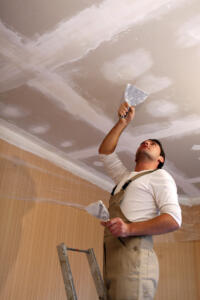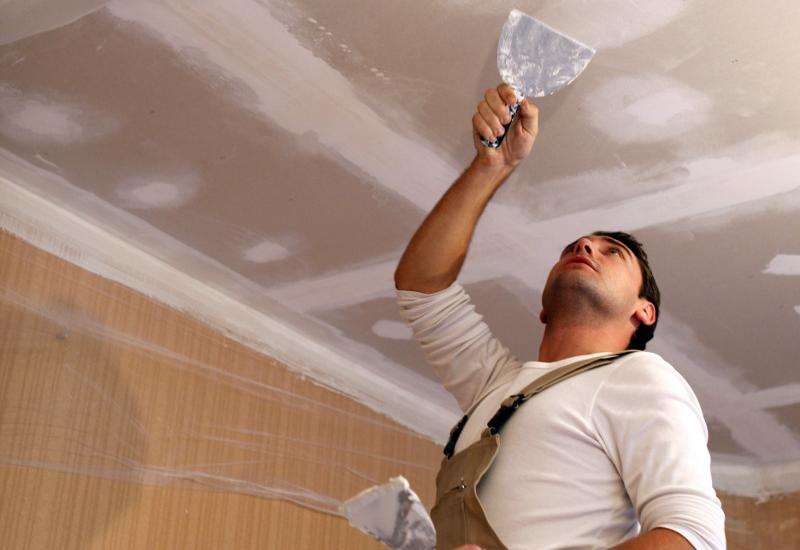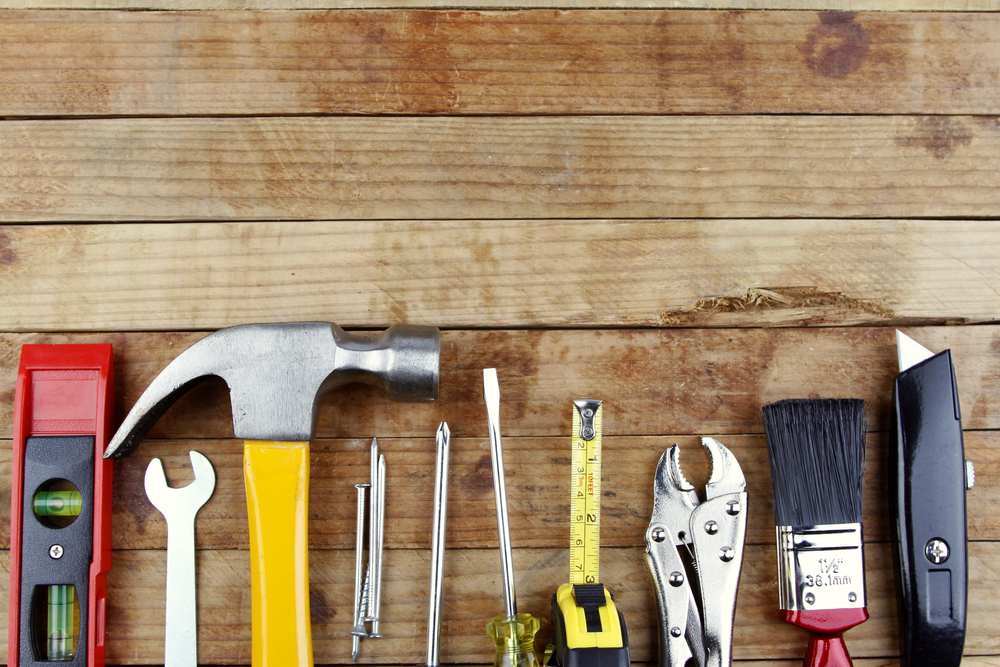
Holes in drywall can be repaired fairly easily, with a minimal amount of equipment and work. Most homeowners can accomplish this with just a few tools.
Drywall is also referred to as plasterboard, wallboard or sheetrock.
Follow these steps in order to repair and conceal drywall holes of all different sizes.
Repairing a Large Hole: 4 to 6 Inches
You can get ready-made patches for drywall. These are available in different home supply centers and hardware stores.
Most offer a “peel-and-stick” type and most patches also have metal backing for additional strength.
If the hole was caused by door knob or other high-speed object, a patch can certainly hide it. However, it may not be strong enough to hold up if there is another impact. If that is the case, then you will need to get a new piece of drywall.
To install a drywall patch, follow these steps.
- First, clean the edges around the hole. Trim away any loose or frayed pieces using a utility knife.
- Shape or cut the patch carefully in order to fit your hole. Be sure to leave a border of extra backing around the patch in order to attach it to the wall that surrounds the hole.
- Clean and then dry the hole, to allow for maximum adhesion. If there are any greasy areas, you can clean them with some tri-sodium phosphate, found in the paint section of a hardware store. You can also just use soapy, warm water. Get the drywall damp enough to clean, but not soaking wet.
- Apply the patch to the wall, and smooth out the taped edges with a putty knife.
- Use a wide blade putty tool in order to spread a very thin layer of compound over the area.
- After it is dry, gently sand the patch to blend it into the wall and repaint.
Repairing Medium-sized Holes: 2 to 4 inches
If the hole is small, you may not need to use a patch. Instead, you can just use some joint compound, also found at a hardware store.
To apply:
- Clean up the area using a utility knife, and then trim away or press back any loose bits that are hanging down.
- Wet the repair area using a spray bottle. This will help the compound stick to the wall. This step can be skipped if you are using a non-water-based compound.
- Once your wall is clean and just a bit damp, apply a good amount of the compound onto a putty knife. Using a wider putty knife will produce a smoother result. Fill the hole and make sure there aren’t any gaps. It’s fine it it sticks out a little – that’s what the next step is for.
- Smooth out the compound using a putty knife. Hold the blade at roughly a 30 degree angle from the drywall, and pull it towards you in just one steady motion.
- Sand gently afterward, and repaint the section of wall if necessary.
Repairing Small Holes: Less than 2 inches
Smaller holes are very easy to repair, and can be unnoticeable if done correctly. You can use either non-shrink drywall compound or spackle.
- Clean up the area that needs to be repaired. Trim away the edges.
- Wet the area very lightly.
- Using a liberal quantity of the compound or spackle and a putty knife, cover the small hole and fill it in.
- Ensure that you smooth out the edges to blend it to the wall.
- Sand it down and paint over as needed.



 You know that great curb appeal your house had when you first bought it? Is it looking a little haggard?
You know that great curb appeal your house had when you first bought it? Is it looking a little haggard?







 This type of theme offers a crisp and clean area to relax in. It is bright and inviting. Create this by adding in white chair covers, table clothes, and more. Other pieces of furniture that are not white should be black metal.
This type of theme offers a crisp and clean area to relax in. It is bright and inviting. Create this by adding in white chair covers, table clothes, and more. Other pieces of furniture that are not white should be black metal. If you like the more modern styles, then you can still have this. If you use earthy colors, you can still offer a mesh of the surroundings from the outside and in.
If you like the more modern styles, then you can still have this. If you use earthy colors, you can still offer a mesh of the surroundings from the outside and in.
 Other times you may be on a tighter budget, and you wonder what will make the most impact on your home, and what will raise the resale value the most.
Other times you may be on a tighter budget, and you wonder what will make the most impact on your home, and what will raise the resale value the most. While you might think that adding travertine tile or granite counters is the best idea, what actually will get you the most return for your investment, should you choose to sell, is making those rooms functional. If the layout is clunky, no matter how gorgeous the kitchen is, no one will want to gather there. Something as simple as replacing the cabinets or extending the counter space could make a huge improvement.
While you might think that adding travertine tile or granite counters is the best idea, what actually will get you the most return for your investment, should you choose to sell, is making those rooms functional. If the layout is clunky, no matter how gorgeous the kitchen is, no one will want to gather there. Something as simple as replacing the cabinets or extending the counter space could make a huge improvement.

 One of the last things to think about when you are replacing the roof is the cost. You need to get in touch with your local roofing contractor to get an estimate on each type of roofing material.
One of the last things to think about when you are replacing the roof is the cost. You need to get in touch with your local roofing contractor to get an estimate on each type of roofing material.



 You can increase your property value by ten percent or more, simply by modernizing it to be more energy-efficient and eco-friendly. Methods for cutting energy costs include sealing or replacing leaky doors, windows, ceilings, walls and pipes.
You can increase your property value by ten percent or more, simply by modernizing it to be more energy-efficient and eco-friendly. Methods for cutting energy costs include sealing or replacing leaky doors, windows, ceilings, walls and pipes.